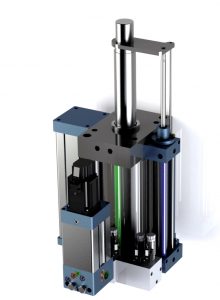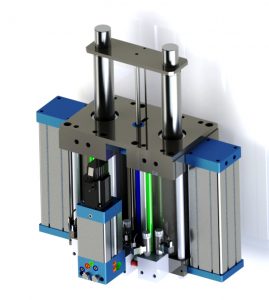Traditional clamp and press mode actuation applications have a rapid stroke at a low force while requiring a steep ramp-up to a high force for a short period. These demanding parameters typically result in the expensive oversizing of the hydraulic infrastructure to meet speed and force requirements.

HSHF single
“high-load” cylinder
Within this large machine footprint, position and force control goals present complex motion and expense variables. In addition to having too many overall pieces in the equation, other factors include: oversized and continuously running pumps, large hoses that often leak and require maintenance, and the energy consuming frequency of stopping/starting with valves repeatedly turning on/off, while transitioning from high speed (low force) to lower speed (high force).
To solve this problem, motion control/actuation specialists Kyntronics, Cleveland, have developed a patent-pending HSHF (High Speed/High Force) All-In-One Actuator. Combining technologies from its servo-based SMART Hydraulic Actuator (SHA), coupled with a high-speed actuator and a high-force pair of actuators — the HSHF is a solution in a scalable, modular, ‘power-on-demand’ machine platform. The design is self-contained with no hoses that eliminates the expensive leaky infrastructure.
The dual cylinder system configuration delivers myriad benefits, resulting in lower operating costs and better performance across a wide range of OEM applications. This actuation technology is a step forward in modularity and takes advantage of hydraulics to overcome inherent issues with existing clamp and press mode technologies including:
CLAMP MODE: In this mode, rapid cycling times are needed while holding a lot of force (170,000 lb-ft / 756 kN) going back and forth. This mode is predominant in injection and blow molding applications which require rapid back/ forth position and hold, which puts a lot of pressure onthe actuator.
Traditional systems include hydraulics that feature check valves that lock in position. These types of systems require a large footprint and higher costs. Electromechani- cal is also an option but requires large and expensive com- ponents including motors, gearboxes, and roller screws/ball screws. Furthermore, the consistent metal-to-metal contact can result in reduced life.
PRESS APPLICATION: Typically, this mode is used for 20-80 ton presses which need to come down quickly, and do work within a small distance (1⁄4 -1⁄2-in. [6-13 mm]) for short periods. This application is dominated by hydraulic systems with huge power units, and excessive pumps and hoses.
The HSHF system provides accurate force control for both clamping and press applications’ performance. This next generation of actuation has rapid movement with high force clamping and a high force press (small distance) — at a low cost, with no hoses, in a small envelope.
The simplicity of this design eliminates oversizing methods and solves several of the issues associated with current options in a cost-effective package — representing upwards of 50% savings in equipment and operating costs.
The reduced space and machine footprint are significant, as it eliminates the hydraulic infrastructure and all oversized elements — providing substantial cost savings. Because it only uses power-on-demand, energy savings are built-in. Because there is no cylinder or pump waiting for the cycle to start, the HSHF uses minimal energy for the long stroke and proportional energy for the load-stroke.
Ease-of-integration with machine control systems and versatile control is also an inherent benefit, as the HSHF Actuator is compatible with Fieldbus, I/O (selectable indexes), and Analog (0-10 Vdc or 4-20 mA).
The HSHF Actuator’s patent-pending concept mechanically connects a high-speed cylinder to a larger high-force dual cylinder. The dual cylinder combines a larger (high-speed zone) cylinder (e.g., a 6-in.) and a slightly smaller (high force zone) cylinder (e.g., a 5-in.) with a piston designed to seal in the smaller cylinder and move freely through the larger cylinder. The high-speed cylinder pulls (e.g., a 1-in.) the dual cylinder’s piston through the longer stroke, (e.g., oil flows freely around the piston) into the smaller cylinder, (high force zone) and seals the piston allowing for either the press or clamp mode.
With SMART actuation, the system knows the exact position where the piston enters the smaller high force cylinder zone and creates a seal. As the smaller high-speed cylinder approaches the high force zone, the system slows down and seamlessly combines the fluid flow to both the high-speed cylinder (e.g., 1-in.) and the high-force cylinder (e.g., 5-in.) without stopping the motion. The system continues to press forward based on force or position. After the operation is completed, the high-speed cylinder retracts, pulling the unique piston back to the retracted position. The high-speed cylinder provides the speed to reduce the overall cycle times with minimal flow, force and heat reducing energy consumption.

HSHF two “high-load”
cylinder combination
During a press mode, maximum power is required for a short period of the cycle (slower speed with high force) — minimizing the motor and drive size along with the overall heat. During a clamp mode, minimum power is required to move the cylinder (extend/retract). During the clamping, zero power is required as the check valves in the HF cylinder lock the actuator in position, and the HS cylinder is placed in float mode to prevent cylinder damage.
The all-in-one operation provides an optimal servo-controlled, closed loop-controlled force, as well as a closed loop-controlled position solution. Vertical market industries such as automotive, aerospace, packaging, and plastics, along with unique applications including injection molding, blow molding, toggle/platen clamping, metal forming, injection carriage actuation, trim press actuation, thermoforming platen actuation, will benefit from HSHF Actuator’s lower costs and higher precision.
According to Kyntronics’ President, Wayne Foley, “The HSHF Actuator is a production enhancing product via cycle time reduction at a lower cost versus current alternative hydraulic and electromechanical options. Accurate position, force, and speed control move quickly under the low load, then the balance of the cycle (5-10%) retracts/repeats quickly like nothing else on the market.”
Kyntronics
kyntronics.com
Filed Under: Cylinders & Actuators